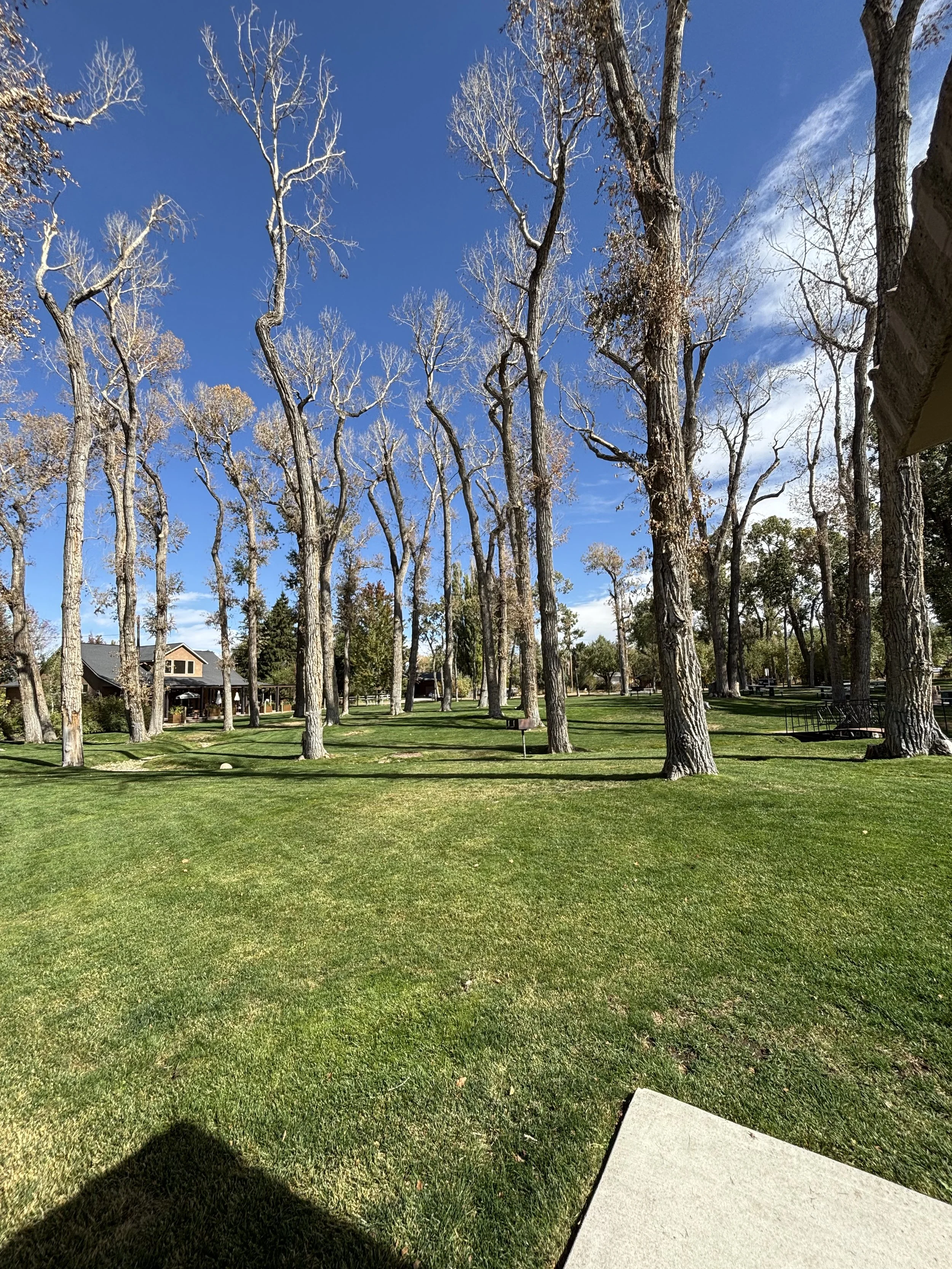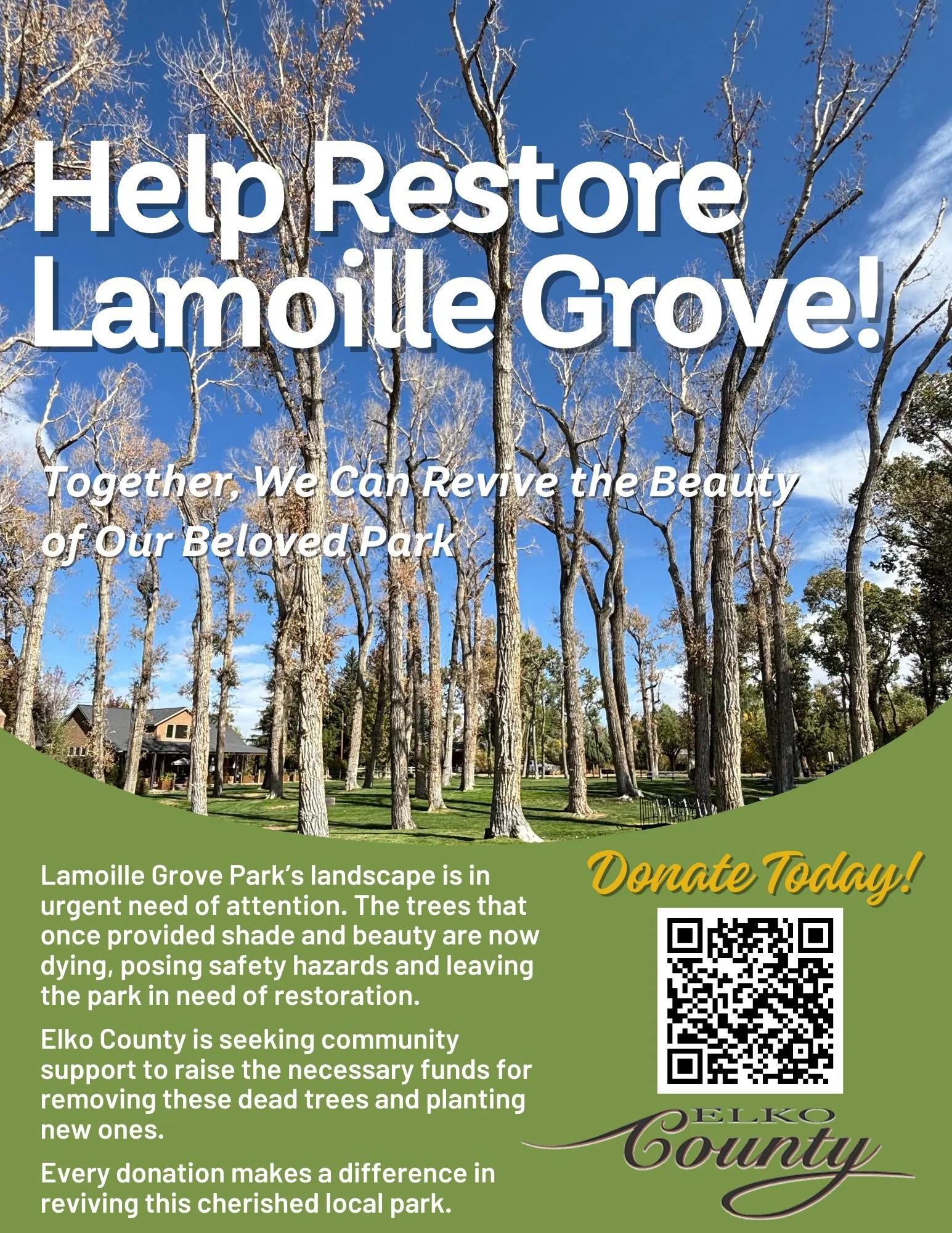Help Restore Lamoille Grove
Trees in Lamoille Grove are dying, and Elko County is faced with the monumental task of removing the dead trees and replacing them with new ones to retain the beauty of the unique gathering spot.
Elko County Commissioners Delmo Andreozzi and Rex Steninger have been tasked with supervising the restoration project and invite community organizations and individuals to help with the project by “buying” a tree.
Steninger explained the county does not really want people buying actual trees, but rather donating money to the project. He added there are over 100 trees in the Grove that need to be replaced and just removing them will cost the county nearly $100,000.
“Then we must start planting new trees. And we want to plant bigger trees that will offer some shade in the not-too-distant future. Those trees aren’t cheap,” he added.
He suggested donations of $1,000 could “buy” a tree and those donors would be recognized on a plaque that would be added at the Grove when the project was completed. Smaller donations will also be appreciated.
Donations may be made to The Grove Project, 540 Court Street, Suite 101, Elko, Nev. 89801 - or online HERE.
Commissioner Andreozzi said, “I’m proud to help with the restoration project and provide the next generation the continued use of the Lamoille Grove, nestled in the heart of Lamoille with a wonderful creek and beautiful views.”
A contractor will begin topping off the dead trees this summer and the county crews will finish the removal process and grind the stumps. The contractor will return to finish the job this winter, when the ground is frozen and damage to the grass will be minimal.
New trees will begin to be planted next spring.
Lizz Todd of Key Marketing Solutions has created a flyer with a QR Code that people can scan with their phones and make donations directly to the restoration. The flyers will be displayed at the Grove and throughout Lamoille.
Doug Clark, a retired U.S. Forest Service employee also has offered his services for the project.
Local historian Janet Petersen says the Lamoille Grove has been a community treasure for over 150 years.
She offered the following report:
Lamoille became known as the “Crossroads” as part of Lander County in 1867. Two roads, one crossing the valley and the other leading from Fort Halleck, met in Lamoille, beneath the Ruby Mountains with a shady grove of stately cottonwood trees nearby.
When Elko County was created out of Lander County in March of 1869, the area became part of Elko County. That same year, John Walker moved his home to a place on Lamoille Creek. There, he built a store, saloon, blacksmith shop and the Cottonwood Hotel. A post office was established in 1872.
The community grew with businesses, lodging and opportunities to quench one’s thirst. Nearby was the Grove (as it had become known) with the small creek and grassy area. The area quickly became a gathering spot for locals and visitors.
Over the Fourth of July in 1875, a grand ball was held in the Grove. A general invitation in the Elko Independent was extended to all to enjoy the festivities and take a stroll through the “Paradise of Nevada.”
The site quickly became a place for socializing. In the early 1870s, Hurdy girls (young women-like Miss Kitty from Gunsmoke, not prostitutes, who would dance for hire with single men) came out from Elko with musicians. They staked out a dance land in the Grove. It was a highly successful venture with cowboys, miners and local folks joining in the fun.
Festivities over the Fourth of July also provided great activities for the entire valley, based at the Grove. The occasion began with a reading of the Declaration of Independence, an oration on patriotism and then games for children of all ages. Of course, a picnic under the trees finished up the day’s celebration.
As automobiles gained popularity, motoring to the Grove became easier and faster. In 1919, the Elko Independent announced the community had plans for construction of tennis courts and camping sites as a wonderful summer resort experience. (The tennis court project never got off the ground.) Agriculturalists, organizing the first Farm Bureau through the Elko County Agricultural agent, met in September of that year and had a picnic.
There was also discussion of proposing Lamoille Canyon as a national park. Small parcels were divided in the town and camping spots offered relief from the summer heat for Elkoans under the trees with the small creek flowing.
In 1924, Charles Noble donated a plot of land to Elko County to expand the site to the size it is in 2025. The town of Lamoille was platted with the Elko County Recorder and some small parcels were sold for summer cottage usage.
Throughout the Depression, the Grove was a popular meeting place for social events. During Prohibition, “under-the-counter” products were also available if one knew how and where to solicit liquid refreshments from the nearby soft drink establishments. Italians in the Lamoille valley would order up to seven train-car loads of grapes from California and produce a fine vintage of wine which was made available to the local population “for medicinal purposes.”. Hard cider was also distilled by some of the Basques in the area. These were shared in the Grove during social gatherings.
When the highway was paved in 1947, a huge three-day celebration and barbeque was held. Most of the Lamoille Valley and many from Elko celebrated the big event in the Grove.
The Lamoille Grove has remained under the management of the Elko County Commission since 1968. Two large barbeques were added and in 1972, picnic tables were placed.
Today, the Grove is host to weddings, memorial services, Everything Elko’s Pumpkin Festival, Elko County Cattlewomen’s Pasture to Plate dinner on June, the annual Ranchers Steak Fry to raise funds for the old school house, the annual Lamoille Country Fair, and new this year the Robin Hood Renaissance Faire.
Photo credits to Northeastern Nevada Museum













